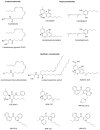Cannabinoids in the Pathophysiology of Skin Inflammation
- PMID: 32033005
- PMCID: PMC7037408
- DOI: 10.3390/molecules25030652
Cannabinoids in the Pathophysiology of Skin Inflammation
Abstract
Cannabinoids are increasingly-used substances in the treatment of chronic pain, some neuropsychiatric disorders and more recently, skin disorders with an inflammatory component. However, various studies cite conflicting results concerning the cellular mechanisms involved, while others suggest that cannabinoids may even exert pro-inflammatory behaviors. This paper aims to detail and clarify the complex workings of cannabinoids in the molecular setting of the main dermatological inflammatory diseases, and their interactions with other substances with emerging applications in the treatment of these conditions. Also, the potential role of cannabinoids as antitumoral drugs is explored in relation to the inflammatory component of skin cancer. In vivo and in vitro studies that employed either phyto-, endo-, or synthetic cannabinoids were considered in this paper. Cannabinoids are regarded with growing interest as eligible drugs in the treatment of skin inflammatory conditions, with potential anticancer effects, and the readiness in monitoring of effects and the facility of topical application may contribute to the growing support of the use of these substances. Despite the promising early results, further controlled human studies are required to establish the definitive role of these products in the pathophysiology of skin inflammation and their usefulness in the clinical setting.
Keywords: cannabinoids; cell signaling; dermatology; inflammation; inflammatory disorders; skin cancer.
Conflict of interest statement
The authors declare no conflict of interest. The funders had no role in the design of the study; in the collection, analyses, or interpretation of data; in the writing of the manuscript, or in the decision to publish the results.
Figures
References
-
- Klumpers L.E., Beumer T.L., van Hasselt J.G., Lipplaa A., Karger L.B., Kleinloog H.D., Freijer J.I., de Kam M.L., van Gerven J.M. Novel Delta(9) -tetrahydrocannabinol formulation Namisol(R) has beneficial pharmacokinetics and promising pharmacodynamic effects. Br. J. Clin. Pharmacol. 2012;74:42–53. doi: 10.1111/j.1365-2125.2012.04164.x. - DOI - PMC - PubMed
Publication types
MeSH terms
Substances
Grants and funding
LinkOut - more resources
Full Text Sources
Medical


